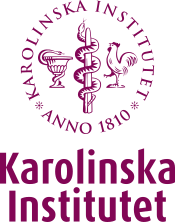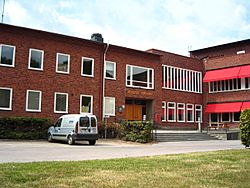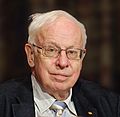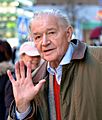Karolinska Institute facts for kids
|
Karolinska Institutet
|
|
 |
|
|
Former names
|
Kongl. Carolinska Medico Chirurgiska Institutet (1817–1968) |
|---|---|
| Motto | Att förbättra människors hälsa (Swedish) |
|
Motto in English
|
To improve human health |
| Type | Public |
| Established | 1810 |
| Endowment | 576,1 million EUR (2010) |
| Budget | SEK 6.67 billion |
| Vice-Chancellor | Annika Östman Wernerson |
|
Administrative staff
|
4,820 (2016) |
| Students | 6,481 (FTE, 2020) |
| 2,039 (2020) | |
| Location |
,
,
Sweden
59°20′56″N 18°01′36″E / 59.34889°N 18.02667°E |
| Campus | Solna (Main) and Flemingsberg |
| Colors | KI Plum |
The Karolinska Institute (KI; Swedish: Karolinska Institutet; sometimes known as the (Royal) Caroline Institute in English) is a research-led medical university in Solna within the Stockholm urban area of Sweden and one of the foremost medical research institutes globally. The Nobel Assembly at the Karolinska Institute awards the Nobel Prize in Physiology or Medicine. The assembly consists of fifty professors from various medical disciplines at the university. The current vice-chancellor of Karolinska Institute is Annika Östman Wernerson, who took office in March 2023.
The Karolinska Institute was founded in 1810 on the island of Kungsholmen on the west side of Stockholm; the main campus was relocated decades later to Solna, just outside Stockholm. A second campus was established more recently in Flemingsberg, Huddinge, south of Stockholm. The institute also has a Centre for Reparative Medicine, consisting of two nodes, one in Stockholm and one in Hong Kong.
The Karolinska Institute is Sweden's third oldest medical school, after Uppsala University (founded in 1477) and Lund University (founded in 1666). It is one of Sweden's largest centres for training and research, accounting for 30% of the medical training and more than 40% of all academic medical and life science research conducted in Sweden. It receives around a third of Sweden's public funding for medical research.
The Karolinska University Hospital, located in Solna and Huddinge, is associated with the university as a research and teaching hospital. Together they form an academic health science centre. While most of the medical programs are taught in Swedish, the bulk of the PhD projects are conducted in English. The institute's name is a reference to the Caroleans.
Contents
Nobel Prize winners
- 1955 Hugo Theorell becomes KI's first Nobel laureate, receiving the Nobel Prize in Physiology or Medicine for his discoveries concerning the nature and mode of action of oxidation enzymes.
- 1967 Ragnar Granit receives the Nobel Prize in Physiology or Medicine for his contributions to the analysis of retinal function and how optical nerve cells respond to light stimuli, colour and frequency.
- 1970 Ulf von Euler receives the Nobel Prize in Physiology or Medicine for his contributions for discoveries concerning the humoral transmitters in the nerve terminals and the mechanism for their storage, release and inactivation.
- 1981 Torsten Wiesel and David H. Hubel jointly receive the Nobel Prize in Physiology or Medicine for their discoveries concerning information processing in the visual system.
- 1982 Sune Bergström and Bengt Samuelsson jointly receive the Nobel Prize in Physiology or Medicine for their discoveries concerning prostaglandins and related biologically active substances.
Seal's symbolism
Rod of Asclepius
The rod of Asclepius is named after the god of medicine, Aesculapius or Asclepius. This ancient god was the son of Apollo and was generally accompanied by a snake. Over time, the snake became coiled around the staff borne by the god.
Snake bowl
The snake bowl was originally depicted together with Asclepius' daughter, the virgin goddess of health Hygieia or Hygiea. The snake ate from her bowl, which was considered to bring good fortune. There is nothing to support the notion that the snake would secrete its venom into the bowl.
Cockerel
The cockerel symbolises new life and was sacrificed to Asclepius by those who had recovered from illness. This is the meaning behind the Greek philosopher Socrates' last words after he drank the poisoned cup: "Crito, we owe a cock to Asclepius. Do pay it. Don't forget."
Education
The Karolinska Institute offers the widest range of medical education under one roof in Sweden. Several of the programmes include clinical training or other training within the healthcare system. The close proximity of the Karolinska University Hospital and other teaching hospitals in the Stockholm area thus plays an important role during the education. Approximately 6,000 full-time students are taking educational and single subject courses at Bachelor and Master levels at the Karolinska Institute. Annually, 20 upper high school students from all over Sweden get selected to attend Karolinska's 7-week long biomedical summer research school, informally named "SoFo".
Departments
- Biosciences and Nutrition
- Cell and Molecular Biology
- Clinical Neuroscience
- Clinical Science and Education, Söder Hospital
- Clinical Science, Danderyd Hospital
- Clinical Sciences, Intervention and Technology
- Dental Medicine
- Environmental Medicine
- Laboratory Medicine
- Learning, Informatics, Management and Ethics
- Medical Biochemistry and Biophysics
- Medical Epidemiology and Biostatistics
- Medicine, Huddinge
- Medicine, Solna
- Microbiology, Tumour and Cell Biology
- Molecular Medicine and Surgery
- Neurobiology, Care Sciences and Society
- Neuroscience
- Oncology-Pathology
- Physiology and Pharmacology
- Public Health Sciences
- Women's and Children's Health
Nobel Assembly at the Karolinska Institute
The Nobel Assembly at the Karolinska Institute is a body at the Karolinska Institute that awards the Nobel Prize in Physiology or Medicine. The Nobel Assembly consists of fifty professors in medical subjects at the Karolinska Institute, appointed by the faculty of the institute, and is a private organisation which is formally not part of the Karolinska Institute. The main work involved in collecting nominations and screening nominees is performed by the Nobel Committee at the Karolinska Institute, which has five members. The Nobel Committee, which consists of members appointed by the Nobel Assembly for a period of three years, is only empowered to recommend laureates, while the final decision rests with the Nobel Assembly.
In the early history of the Nobel Prize in Physiology or Medicine, which was first awarded in 1901, the laureates were decided upon by the entire faculty of the Karolinska Institute. The reason for creating a special body for the decisions concerning the Nobel Prize was the fact that the Karolinska Institute is a state-run university, which in turn means that it is subject to various laws that apply to government agencies in Sweden and similar Swedish public sector organisations, such as freedom of information legislation. By moving the actual decision making to a private body at Karolinska Institute (but not part of it), it is possible to follow the regulations for the Nobel Prize set down by the Nobel Foundation, including keeping the confidentiality of all documents and proceedings for a minimum of 50 years. Also, the legal possibility of contesting the decisions in e.g. administrative courts is removed.
The other two Nobel Prize-awarding bodies in Sweden, the Royal Swedish Academy of Sciences and the Swedish Academy, are legally private organisations (although enjoying royal patronage), and have therefore not had to make any special arrangements to be able to follow the Nobel Foundation's regulations.
Notable alumni or faculty
- Jöns Jakob Berzelius (1779–1848; professor at KI), invented modern chemical notation and is considered one of the fathers of modern chemistry; discoverer of the elements silicon, selenium, thorium, and cerium
- Carl Gustaf Mosander (1792–1858; student of chemist Jöns Jacob Berzelius, his successor 1836), chemist, discoverer of the elements lanthanum, erbium and terbium.
- Axel Key (1832–1901), pathologist, rector 1886–1897, founder of what would become the Journal of Internal Medicine
- Julia Winter
- Gustaf Retzius (1842–1919), anatomist (professor 1877–1890)
- Karl Oskar Medin (1847–1928), paediatrician, famous for his study of poliomyelitis (professor 1883–1914)
- Wilhelm Netzel (1834–1914), Swedish researcher, gynecologist and obstetrician
- Ivar Wickman (1872–1914), pediatrician, pupil of Medin, polio expert
- Göran Liljestrand (1886–1968), physiologist and pharmacologist
- Nanna Svartz (1890–1986), first female professor at Karolinska Institute and, as a result, the first woman to be appointed professor at a public university in Sweden ever; researcher in gastrointestinal diseases and rheumatologist
- Ulf von Euler (1905–1983), physiologist, Nobel Laureate in Physiology or Medicine in 1970
- Herbert Olivecrona (1891–1980), founder of Swedish neurosurgery
- Ragnar Granit (1900–1991), Nobel Laureate in Physiology or Medicine in 1967
- Hugo Theorell (1903–1982), Nobel Laureate in Physiology or Medicine in 1955
- Lars Leksell (1907–1986), physician, inventor of radiosurgery and the Gamma Knife
- Sune Bergström (1916–2004), Nobel Laureate in Physiology or Medicine in 1982 (with Bengt I. Samuelsson and John Robert Vane)
- Pehr Edman (1916–1977), chemist (Med. dr 1946). Cf. Edman degradation
- Sven Ivar Seldinger (1921–1998), radiologist, inventor of the Seldinger technique
- Torsten Wiesel (born 1924), Nobel Laureate in Physiology or Medicine in 1981
- Carl-Gustav Groth (1933–2014), pioneer of organ transplantation
- Bengt I. Samuelsson (born 1934), Nobel Laureate in Physiology or Medicine in 1982 (with Sune Bergström and John Robert Vane)
- Tomas Lindahl, Nobel Laureate in Chemistry in 2015 (with Paul Modrich and Aziz Sancar), cancer researcher and winner of the Royal Medal
- Lennart Nilsson (1922–2017), computational biologist, photojournalist, and Emmy-award-winning documentarian
- Johan Harmenberg (born 1954), Olympic champion épée fencer
See also
 In Spanish: Instituto Karolinska para niños
In Spanish: Instituto Karolinska para niños
- Karolinska Institute Prize for Research in Medical Education
- Sahlgrenska University Hospital
- Royal Institute of Technology
- Stockholm School of Economics
- Stockholm University
- The New Karolinska Solna University Hospital, opened in 2015
- S*, a collaboration between seven universities and the Karolinska Institute



















